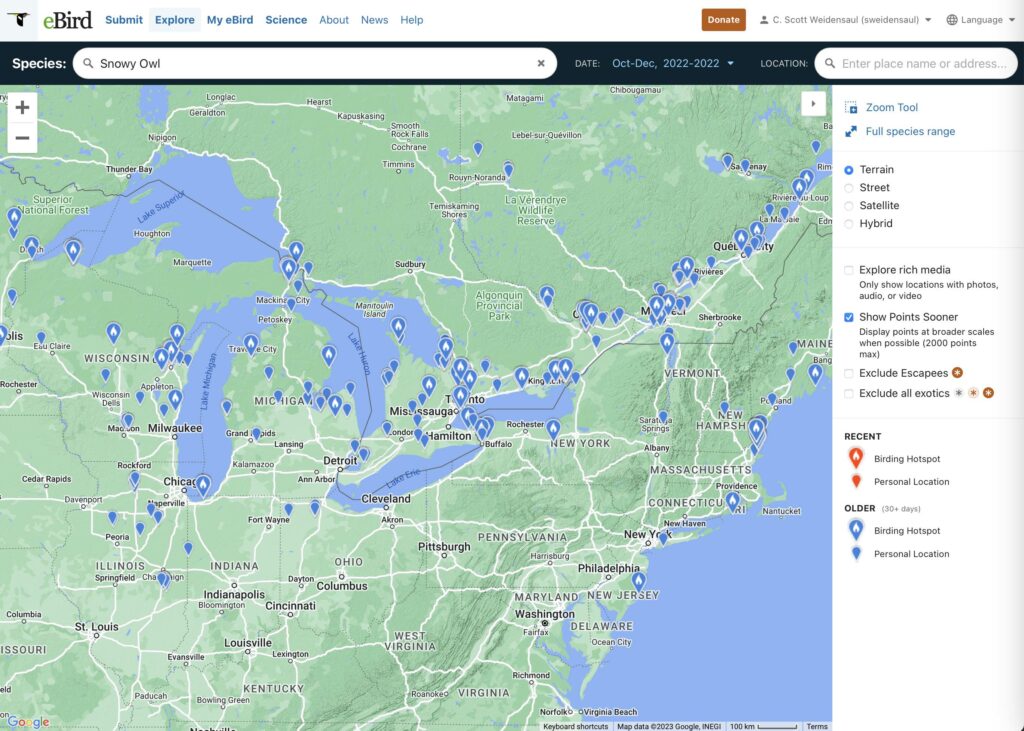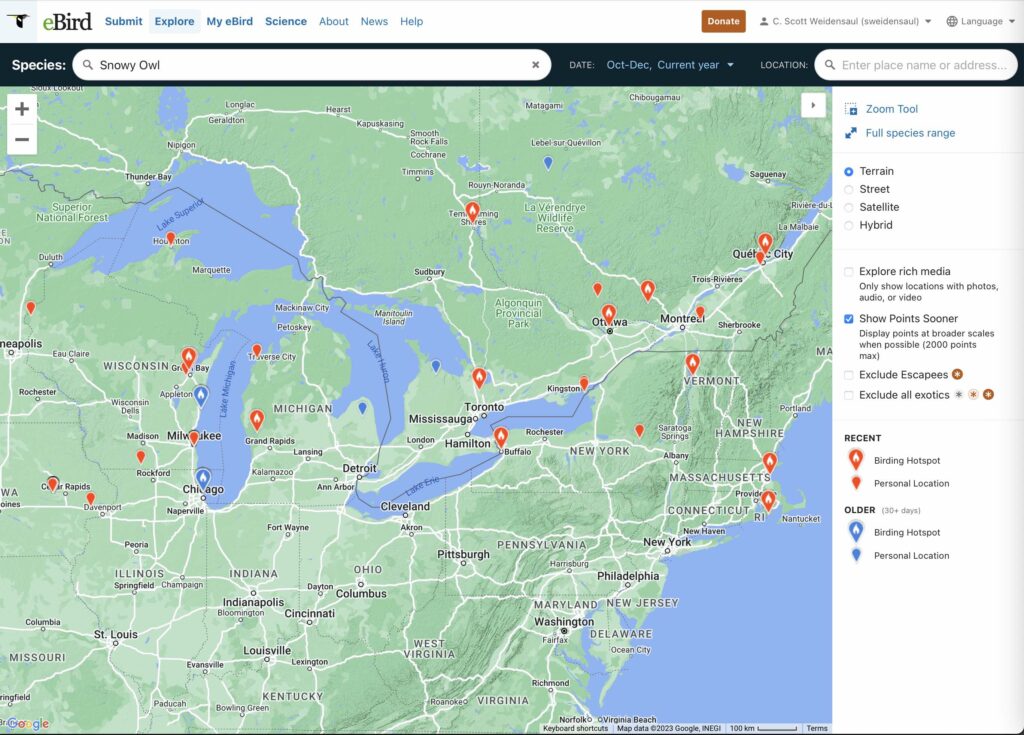
Maps from eBird show snowy owl reports from Oct.-Dec. 2022 (above) and the same period this year (below). The difference is stark — and it’s worth noting that we considered last year a slow one for snowy owls, too. (©Cornell Lab of Ornithology)
 One thing about studying a species with cyclical or irregular movements, like snowy owls, is that every once in a while you hit a dull stretch. And in the East and upper Midwest, where Project SNOWstorm primarily works, it’s definitely one of those winters.
One thing about studying a species with cyclical or irregular movements, like snowy owls, is that every once in a while you hit a dull stretch. And in the East and upper Midwest, where Project SNOWstorm primarily works, it’s definitely one of those winters.
So far, there have been only a handful of snowy owls reported from the western Great Lakes east to southeastern Canada, New York and New England. Usual hotspots like the Ottawa River Valley in southern Ontario have one or none being reported on eBird (which won’t pick up every snowy owl, but will show most of them). None of our six previously tagged owls from last winter has shown up in cell range yet, including Otter, whom we were able to track all summer using the Argos satellite portion of his hybrid transmitter. (That story is here.)
In fact, you have to go back to the early winter of 2010 to find a year with so few snowy owl reports in eastern and central North America. The Audubon Christmas Bird Count (CBC) tallied just five snowy owls continent-wide that year. While this isn’t a lot of fun for those of us hoping to have lots of white owls to liven the winter landscape, such off-years are most likely just part of the periodic boom and bust in snowy owl breeding ecology. Occasionally you get a summer when there was a widespread lack of lemming production in the Arctic, and thus a poor breeding season for the owls and fewer young birds coming south.
That this isn’t usually a permanent state of affairs is reflected by what happened in 2013, just three years after that painfully slow winter. A lemming mega-boom in northern Québec sparked the biggest irruption of snowy owls in memory the winter of 2013-14, and also sparked the creation of Project SNOWstorm. (That year, some 336 snowies were counted on the CBC.)
There have been more snowies appearing in the Canadian prairies this year, but our colleagues there report they are almost all adults, and those they have been catching have been in fairly poor body condition, which also suggests this was a low year for small mammals in the central Canadian Arctic.
The unusually mild winter weather so far, perhaps fueled by a powerful El Niño, may also be conspiring to keep owls farther north than normal. If there is one darker uncertainty, though, compared with earlier off-years, it’s the possible effects of highly pathogenic avian influenza (HPAI), which emerged two winters ago and which we know has hit snowy owls fairly hard. We suspect HPAI is the reason so few of our previously tagged owls returned last winter, and while we suspect this winter’s poor showing is more likely a normal dip in the periodic boom and bust, we can’t be certain avian flu isn’t exacerbating it.
In the past week or so, a few more snowies have shown up in the East, so we may a late push, especially if we get some cold and snowy weather to the north. Our tagging teams are ready if owls appear in their areas, but in the meantime, there’s not much to do but wait. In long-term studies like SNOWstorm, we have to remind ourselves that seemingly dull winters like this one are as important to understanding the dynamics of snowy owls as the busy, exciting ones.


10 Comments on “It’s Quiet…Too Quiet?”
North Dakota had been very slow up through mid-December, with only two eBird sightings early in the month. One sighting was within a stone’s throw of the Canadian border north of Minot, and the other in the north-central part of the state. In the last few days, we finally had one show up in the Grand Forks area, and at least one in the Fargo area. I don’t know if our lack of snow in the Fargo area may be contributing to the slow appearance of the birds or not (do they “need” or prefer snow for hunting success? Let me know your thoughts, please), and we have one other factor near Fargo that may be contributing (a huge river diversion project bulldozing miles of natural habitat and farm fields in what has historically been prime Snowy winter hunting areas). I was quite happy to finally see a Snowy in West Fargo a few days ago, as I was concerned we might not see any at all close to town this year due to the river diversion project, but we’ll have to see how many we get compared to other undisturbed areas before we’ll know if the river project is affecting our sightings. Heck, it may even improve sightings in some areas if displaced prey species overrun nearby fields.
I have a feeling the issues in ND are more general than a lack of local snow and habitat loss, though the latter certainly doesn’t help. Given the lack of significant snow cover to the north, it’s possible any owls moving south don’t have to come very far into, say, Manitoba to find decent hunting areas. The current snow cover maps for Canada (https://ccin.ca/home/sites/default/files/snow/snow_tracker/plot_anom_sdep.png) show minimal snow pack just north of the U.S. border.
Like everyone in the New England region I’m hoping for a return of these beautiful birds. I was spoiled by the first year I enjoyed them here in RI which was 2013./14. For now we are having to settle for others posting pics from better days.
If 2013-14 was your first year, you may have been spoiled for life! That may well literally have been a once-in-a-lifetime phenomenon for most of us. But we can keep hoping.
I have observed two or three owls near my home every year since 2018, but none this year so far.
Yes, I had been saying this winter is similar to winter 2010-2011 (Nov. 2010 to March 2011). I had an inkling back in late November of this year, based on the lack of sightings, that this will be a bad winter for seeing snowy owls.
The good news is we’ve hit bottom which means the following years will onbly get better for snowy owl sightings down here.
I have only had one sighting so far. On December 13th, I saw an adult male in far western Minnesota between the Fargo and Grand Forks area. Last year I was able to observe 2 pairs in my commuting area which runs from Hwy 9 to Crookston.
I was in the high arctic this summer in July – Somerset Island. There were absolutely NO lemmings anywhere on the island this summer. Usually there are nesting snowy owls, fox kits & wolf cubs. This year there was no food for any of these species. Granted this was only one locale, but if the same conditions are occurring in the region it might explain the dearth of owls this season. On the other hand, a friend who was fishing in Alaska mentioned it was thick with lemmings where he was in the bush. I live in WA state – so far no sightings in our usual areas for 23-24.
Thanks for the report from Somerset, Christy — as you know, one of the issues with trying to grasp how well or poorly an Arctic species like snowy owls are doing in any particular year is the immensity of the landscape and thin human population. But we really heard of no breeding activity anywhere except Axel Heiberg Island in the extreme northern Arctic. I keep reminding myself it was this poor a winter in 2010-11 and two years we had an epic irruption.
I saw one this morning in Central VA. I just happened to be looking out a window when a big white bird flew across a neighbor’s field. It wasn’t a seagull.